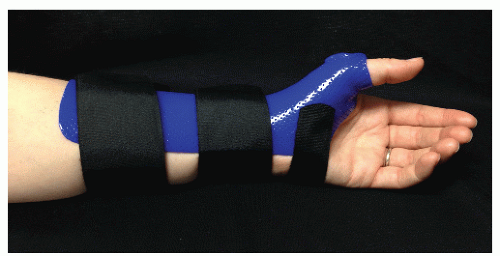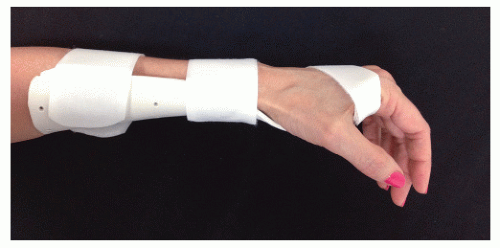Hand and Wrist Rehabilitation
Gayle K. Severance
Laura Walsh
Hand Therapy
“A hand therapist is an occupational therapist or physical therapist who, through advanced study and experience, specializes in treating individuals with conditions affecting the hands and upper extremity. A hand specialist may also have advanced certification as a Certified Hand Therapist (CHT).” (per ASHT Web site) To find a hand therapist in your area, please refer to the following Web sites: www.ASHT.org and www.HTCC.org.
CARPAL TUNNEL SYNDROME
Orthosis
The primary conservative treatment for carpal tunnel syndrome (CTS) is use of a wrist orthosis (splint). Referral to a hand therapist for a custom-fit orthosis, which holds the wrist in a neutral position, is recommended (Fig. 72-1). Compressive forces to structures in the carpal canal occur when the wrist is in flexion or extension.1,2 Over-the-counter wrist splints often position the wrist in slight extension and contribute to symptoms. If this type of splint is used, it should be modified to a wrist-neutral position. For patients with well-developed lumbrical muscles (i.e., heavy laborers), hand swelling, or concomitant trigger finger pathology, consider including the metacarpophalangeal (MCP) joint at 20 to 40 degrees of flexion to prevent lumbrical excursion into the carpal canal1,3 (Fig. 72-2). The orthosis is worn while sleeping and during aggravating activities. For individuals with more advanced symptoms, increased time in the orthosis may be appropriate. However, prolonged wear may lead to wrist stiffness and weakness, as well as shoulder pain from compensatory movements, so a wearing schedule should be established.
Home Program
In addition to an orthosis, patients should be instructed to modify activities by avoiding repetitive or sustained gripping and pinching, avoiding prolonged wrist flexion and extension postures, and avoiding vibratory tools. Proper ergonomic postures and frequent, short rest breaks should be encouraged. A home exercise program (HEP) including nerve glides and tendon glides may be utilized in some cases, but there is a lack of evidence as to the efficacy, as well as the intensity, and duration the exercises should be performed.4 Therefore, we practice a regime of splinting and activity modification for treatment of mild to moderate CTS.
In cases of severe CTS, or when conservative treatment does not relieve symptoms after 2 to 3 months, surgical intervention may be necessary. Postoperative hand therapy is beneficial to address wound/scar, edema, pain, sensory issues, range of motion (ROM), fine motor coordination, and strengthening to restoring functional use of the affected hand.
DE QUERVAIN TENOSYNOVITIS
Conservative treatment may include any combination of orthoses, thermal modalities, exercise, injection, transdermal drug delivery (iontophoresis/phonophoresis), and activity modification and should be tailored to the individual patient.5,6,7
Orthosis
Patients are referred to hand therapy for orthotic fabrication. The orthosis positions the wrist in slight extension with the thumb carpometacarpal (CMC) and MP joints halfway between palmar and radial abduction to unload the tendons. Interphalangeal (IP) joint remains free (Fig. 72-3). Volar based versus radial based is often determined by patient comfort and dominance. A radial-based orthosis is more comfortable and user friendly when the dominant hand is involved. However, there is a lack of strong evidence in the literature for the use of orthoses.5 Variability in orthotic design, wearing schedule, duration, acute versus chronic cases, patient compliance, and a number of other factors may contribute to the orthosis
effectiveness. Yet, in cases where an injection is not appropriate due to certain medical conditions or when the patient declines, an orthosis can be an appropriate form of intervention to decrease pain.
effectiveness. Yet, in cases where an injection is not appropriate due to certain medical conditions or when the patient declines, an orthosis can be an appropriate form of intervention to decrease pain.
Local corticosteroids may be injected into the first dorsal compartment by a physician or delivered via iontophoresis in therapy. Success rates following one to two injections range from 50% to 90%.5,6,7 Research suggests that iontophoresis is effective in controlling pain and inflammation particularly for patients who cannot tolerate injections.5,7 Iontophoresis is performed in a therapy setting; therefore, the patient should be given a prescription for the therapy intervention as well as a second prescription to obtain the medication from a pharmacy (dexamethasone sodium phosphate 4 mg/mL, obtain 15 mL). Common practice is to perform three treatments, preferably every other day for 1 week; if the patient reports some relief of symptoms, three more treatments are performed for a total of six treatments. Iontophoresis treatment is discontinued if no relief is reported after three treatments.
Home Program
A HEP of active thumb flexion with passive extension allows for gentle mobility of the radial-based tendons and joints as well as the dorsal radial sensory nerve (Fig. 72-4). Instead of a strengthening program, patients are educated on proper hand postures to resume functional activity without re-exacerbating the condition. Patients should be advised to limit activities that position the wrist ulnar deviation, especially with thumb abduction and extension (i.e., picking up a young child, cradling an infant, using a mouse, texting, and using a screwdriver with wrist in flexion with a twisting motion).
 FIGURE 72-3. Custom-fabricated orthosis with wrist in slight extension, thumb between palmar and radial abduction and IP joint free.
Stay updated, free articles. Join our Telegram channel
Full access? Get Clinical Tree
 Get Clinical Tree app for offline access
Get Clinical Tree app for offline access

|






